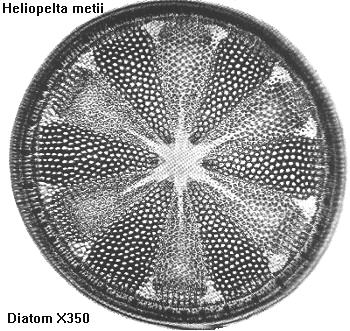In these days of modern
microscopes with flat field objectives, quartz halogen illumination, electronic
exposure determination and sensitive film emulsions, spare a thought for
the microscopist a hundred years ago striving to take a good photomicrograph.
Despite the difficulties, the early workers often achieved quite remarkable
results.
Perhaps there are parallels with
the photographers of that era. The quality of many of the early landscape
and portrait photographs both technically and artistically are still very
much admired today. Like the photographers, the photomicrographers of that
era knew how to get the most out of the equipment and materials at their
disposal.
A book that demonstrates this extremely
well is 'Nature Through Microscope and Camera' by Richard Kerr with photomicrographs
by Arthur E. Smith. This fascinating book published in 1905 often crops
up in the second-hand bookshops and is worth looking out for.
The picture below shows a photomicrograph,
and I hope you'll agree that given that the scan is from a 92 year old
book illustration (Fig. 3 from this book) not the original photo', it is
a photomicrograph that would be more than acceptable if it had been taken
on a modern microscope (some distortion has occurred in scanning). The
book includes photomicrographs taken at a wide range of magnifications,
including the detail of diatoms at 1750X and 'macro' shots of beautifully
laid out whole insects at 8X.


The photograph of this equipment
makes me smile every time I see it. They don't make them like that anymore!
You can just about see the piece of string the user is holding to adjust
the focus on the microscope. The photomicrographer Arthur Smith mentions
that the impressive bellows extension was required to project the image
onto the large 12 x 10 inch photographic plates.
Mr Smith also stressed that achromatic
objectives were used for all the book plates and no retouching of the negatives
was carried out. Although the higher quality apochromatic objectives were
certainly available at the turn of the century, they would have been very
expensive for the average amateur. The author was keen to demonstrate what
could be achieved by getting the most out of modest optics.
He apparently avoided the temptation
to use the most intense sources of illumination available at that time,
namely 'oxy-hydrogen lime-light' or 'electric light'. Presumably the illumination
was a more conventional gas lighting, and exposures were stated to be between
two seconds and two hours or longer. Coloured filters to control the contrast
on some subjects were also employed.
As an aside, Richard Kerr the author
of the book described above, adopts a somewhat moral tone in the introduction
which was often the case in books of this era. However, in these days of
instant entertainment with TV, computer games and amusement arcades maybe
his remarks still provide food for thought!
'There are too many places of
amusement in our cities, too many trashy and pernicious novels in our free
libraries .......
We do not suggest photography
through the microscope as the remedy for existing defects, but we think
that the more our young men take up intellectual pastimes the better it
will be for the nation.'
As a final thought, what will
writers a hundred years from now think of our photomicrography techniques?
Silver based image recording is already being replaced by digital techniques,
and although a photomicrographer from 1900 would probably recognise with
guidance many of the features of a modern photomicroscope, would we recognise
the equipment used to take images of microscopical images in 2097. Who
knows?!
Sources of information and further
reading
1) 'Nature Through Microscope
and Camera' by Richard Kerr with photomicrographs by Arthur E. Smith.
Published by The Religous Tract Society, London 1905.
2) 'Recording the image - past
and present' by S. Bradbury. Quekett Journal of Microscopy, 1994, Volume
37 (part 4), pp. 281 - 295. A well illustrated historical overview of image
recording techniques including photomicrography.
3) 'The Microscope Past and Present'
by Savile Bradbury. Pergamon Press, London, 1968. A concise discussion
of the history and development of the microscope.
Comments
to the author welcomed.

